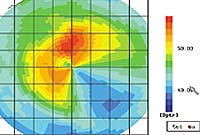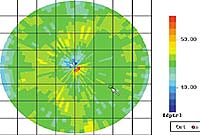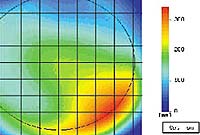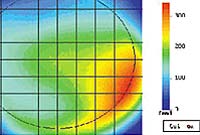Topo-link ablation compares favorably with standard LASIK, but alignment must be improved
Study confirms efficacy and predictability of the method on regular corneas, but a more efficient method needed for irregular corneas.
VENICE – A comparative study shows that even at this present, still imperfect, stage, topo-link ablation presents some noteworthy advantages over standard laser in situ keratomileusis (LASIK) ablation. According to Thomas Neuhann, MD, who spoke on the subject at the Venice 2000 meeting sponsored by Ocular Surgery News, the International Society of Refractive Surgery and the Associazione Italiana di Chirgia della Cataratta e Refrattiva, "it is a valid tissue-sparing option, with high predictability and good refractive results when applied to regular corneas." However, he pointed out that disappointing outcomes often occur with irregular corneas, mainly due to the imperfect alignment systems presently in use.
Facing up to facts
 ---Preoperative topography simulating a misalignment of a customized ablation profile.
---Preoperative topography simulating a misalignment of a customized ablation profile.
(COURTESY OF THOMAS NEUHANN, MD; MARKUS BAUER, MD OF THE ALZ AUGENKLINIK, MUNCHEN, GERMANY.)
"The basic principle of topo-link is entirely convincing. It consists of an individual algorithm based on topographic maps instead of a general algorithm based on a formula," Dr. Neuhann said.
"However, besides the many successful cases of which we are proud, there are almost as many cases of failure. Naturally, we tend to gloss over them," he said.
Dr. Neuhann's study was aimed at testing the facts, rather than the principles of topo-link ablation, comparing a high number of cases treated with this method with a similar number of patients treated with standard LASIK.
The surgical equipment consisted of a Keracor 217 by Technolas, a Hansatome microkeratome and a C-Scan by Technomed.
"Customized topo-link ablation was performed on 133 eyes, using a 2 mm/1 mm TL-algorithm. Mean age of patients was 35 years. Maximum desired ablation was –10 D. The mean spherical correction was –5.25 D ± 2.4 D. Mean cylinder was –1.25 D ± 1.0 D," Dr. Neuhann said.
"The standard LASIK group consisted of 319 eyes, corrected with a 2-mm planoscan algorithm based on the Munnerlyn formula. The mean age of patients was 38 years. Maximum desired ablation was also – 10 D. The mean spherical equivalent was –6.25 D±2.5 D. The mean cylinder was –1.5 D±1.2 D. Results were compared at 3 months."
Encouraging data
 ---Simulation resultshowing a calculated ablation profile.
---Simulation resultshowing a calculated ablation profile.
(COURTESY OF THOMAS NEUHANN, MD; MARKUS BAUER, MD OF THE ALZ AUGENKLINIK, MUNCHEN, GERMANY.)
"Concerning the predictability of the sphere, the customized ablation group reached the aimed refraction in 80% of cases within ± 0.5 D and in 94% of cases within ± 1.0 D," Dr. Neuhann said.
Standard LASIK showed inferior results. Target refraction was achieved within ± 0.5 D in 67% of cases and within ± 1.0 D in 86%.
If predictability of the sphere was better in the topo-link group, the same did not apply to the cylinder, where predictability values were almost equal in the two groups (80% vs. 79% within ± 0.5 D and 93% vs. 91% within ± 1.0 D).
"A successful cylinder ablation depends on the alignment of the cylinder axis, and this particular parameter is not better in either method," Dr. Neuhann said. "But, we'll return to this problem later," he anticipated.
Safety was measured on best-corrected visual acuity pre- and postop and was equal in both groups.
"Postoperatively, 98% of topo-link LASIK patients and 97% of standard LASIK patients were within one line of preoperative best corrected visual acuity. At 3 months, only 2% and 3% respectively had lost two lines. None lost more than two lines. After 6 months, even those had gone back to preoperative values."
The most significant test of the efficacy of the method is the comparison between preoperative best-corrected visual acuity and postoperative uncorrected visual acuity. As Dr. Neuhann pointed out, patients want to see as well without glasses after surgery as they saw with glasses before.
"We calculated that 82% of topo-link LASIK patients were within one line compared with preoperative best corrected visual acuity, which is a very good percentage," he said. "This value drops to 71% in the standard LASIK group."
Alignment
In conclusion, topo-link ablation comes out as a winner, Dr. Neuhann said. Predictability of the sphere is considerably better, and efficacy is better. Predictability of the cylinder and safety is equal.
The validity of the principle has been proven by facts.
"This demonstrates we are on the right path. To go further and to deal successfully with more irregular corneas and complex ablations, we must find a way of making sure that what we plan on the maps is exactly what we do on the eye. For this purpose, tracking the ablation with the eye tracker is a must, especially with irregular corneas," Dr. Neuhann said.
"Alignment is our next challenge," he continued. "In grossly irregular corneas, a slight deviation of the eye under the laser from the position the same eye had before the topographer can make things worse rather than better. By missing the correct location of a calculated customized treatment, not only the correction will be incomplete, but the resulting corneal surface will be even more irregular."
Dr. Neuhann is currently working on an iris-based alignment system.
"This will allow us to make the position of the eye under the laser coincide with that of the eye in the maps. In this way, topo-link ablation will be far more reliable and effective in all cases."
  Simulated estimated topography result showing perfect alignment. (COURTESY OF THOMAS NEUHANN, MD; MARKUS BAUER, MD OF THE ALZ AUGENKLINIK, MUNCHEN, GERMANY.) | |
  Simulated estimated topography result showing a misalignment of 20. (COURTESY OF THOMAS NEUHANN, MD; MARKUS BAUER, MD OF THE ALZ AUGENKLINIK, MUNCHEN, GERMANY.) |
For Your Information:
- Thomas Neuhann, MD, can be contacted at Helene Weber Allee 19, D 80637 Munchen, Germany; (49) 89-1594040; fax: (49) 89-15940555; e-mail: thomasneuhann@compuserve.com.
